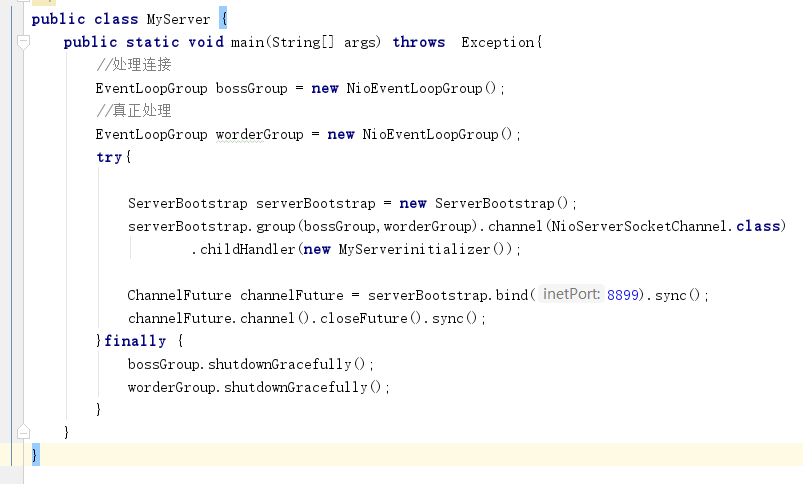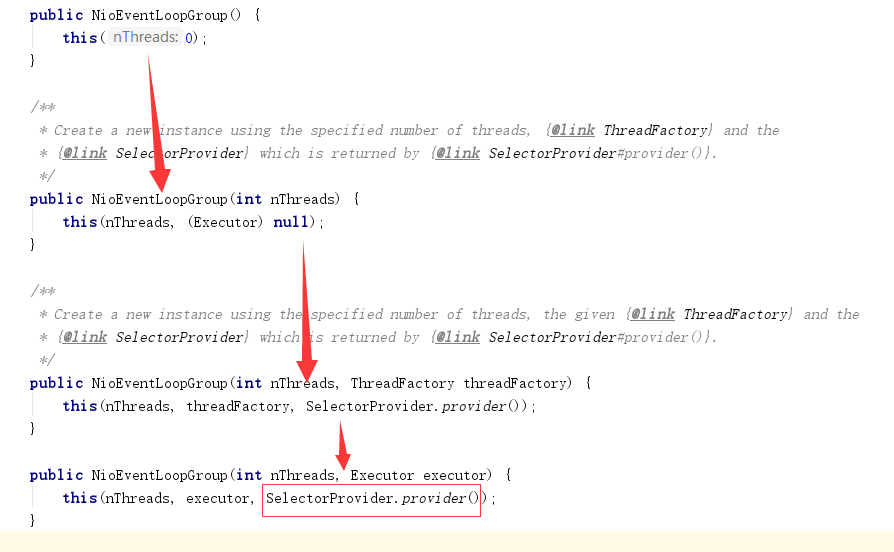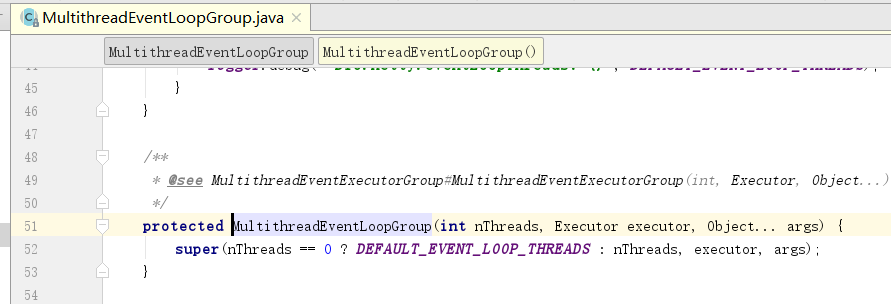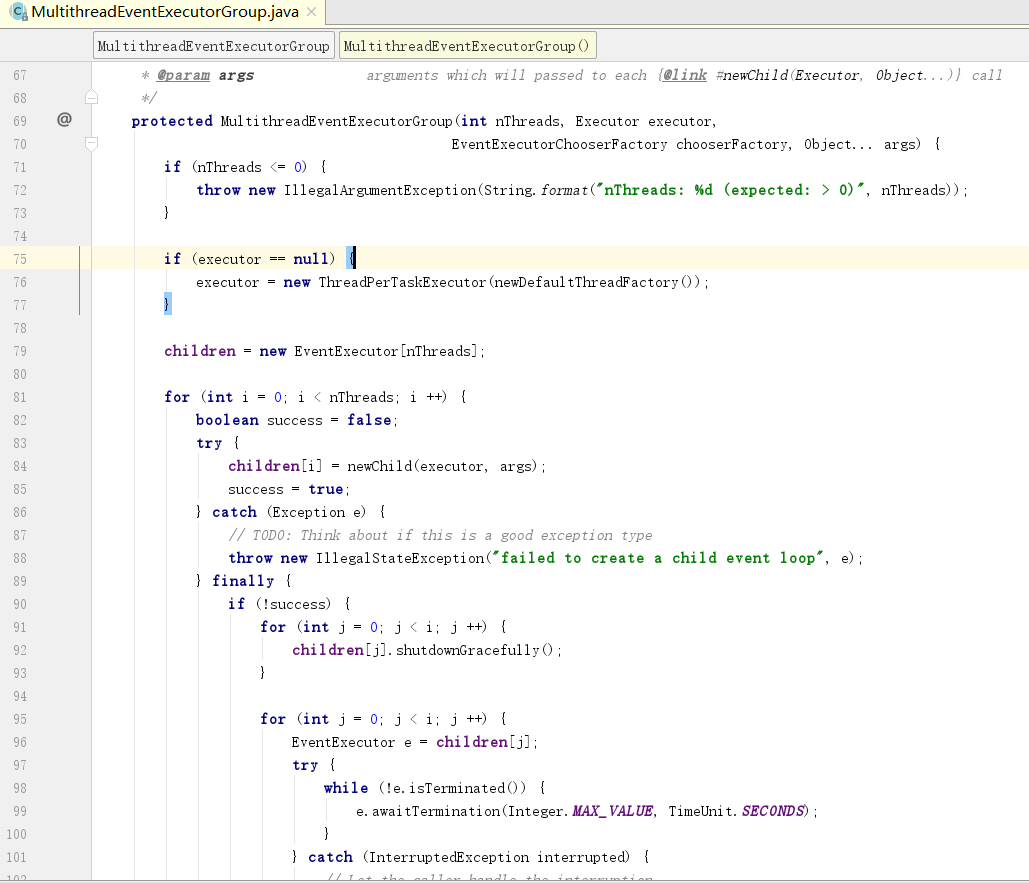NioEventLoopGroup源码分析与线程设定
我的以Netty Socket编程的代码为例,

1、EventLoopGroup
进入EventLoopGroup,这是一个特殊的EventExecutorGroup,在事件循环中,在selection选择的时候,可以注册Channel。(Channel可以理解为跟客户端的连接)
/**
* Special {@link EventExecutorGroup} which allows registering {@link Channel}s that get
* processed for later selection during the event loop.
*
*/
public interface EventLoopGroup extends EventExecutorGroup {
/**
* Return the next {@link EventLoop} to use
*/
@Override
EventLoop next(); /**
* Register a {@link Channel} with this {@link EventLoop}. The returned {@link ChannelFuture}
* will get notified once the registration was complete.
*/
ChannelFuture register(Channel channel); /**
* Register a {@link Channel} with this {@link EventLoop} using a {@link ChannelFuture}. The passed
* {@link ChannelFuture} will get notified once the registration was complete and also will get returned.
*/
ChannelFuture register(ChannelPromise promise); /**
* Register a {@link Channel} with this {@link EventLoop}. The passed {@link ChannelFuture}
* will get notified once the registration was complete and also will get returned.
*
* @deprecated Use {@link #register(ChannelPromise)} instead.
*/
@Deprecated
ChannelFuture register(Channel channel, ChannelPromise promise);
}
2、EventExecutorGroup
/**
* The {@link EventExecutorGroup} is responsible for providing the {@link EventExecutor}'s to use
* via its {@link #next()} method. Besides this, it is also responsible for handling their
* life-cycle and allows shutting them down in a global fashion.
*
*/
public interface EventExecutorGroup extends ScheduledExecutorService, Iterable<EventExecutor> { /**
* Returns {@code true} if and only if all {@link EventExecutor}s managed by this {@link EventExecutorGroup}
* are being {@linkplain #shutdownGracefully() shut down gracefully} or was {@linkplain #isShutdown() shut down}.
*/
boolean isShuttingDown(); /**
* Shortcut method for {@link #shutdownGracefully(long, long, TimeUnit)} with sensible default values.
*
* @return the {@link #terminationFuture()}
*/
Future<?> shutdownGracefully(); /**
* Signals this executor that the caller wants the executor to be shut down. Once this method is called,
* {@link #isShuttingDown()} starts to return {@code true}, and the executor prepares to shut itself down.
* Unlike {@link #shutdown()}, graceful shutdown ensures that no tasks are submitted for <i>'the quiet period'</i>
* (usually a couple seconds) before it shuts itself down. If a task is submitted during the quiet period,
* it is guaranteed to be accepted and the quiet period will start over.
*
* @param quietPeriod the quiet period as described in the documentation
* @param timeout the maximum amount of time to wait until the executor is {@linkplain #shutdown()}
* regardless if a task was submitted during the quiet period
* @param unit the unit of {@code quietPeriod} and {@code timeout}
*
* @return the {@link #terminationFuture()}
*/
Future<?> shutdownGracefully(long quietPeriod, long timeout, TimeUnit unit); /**
* Returns the {@link Future} which is notified when all {@link EventExecutor}s managed by this
* {@link EventExecutorGroup} have been terminated.
*/
Future<?> terminationFuture(); /**
* @deprecated {@link #shutdownGracefully(long, long, TimeUnit)} or {@link #shutdownGracefully()} instead.
*/
@Override
@Deprecated
void shutdown(); /**
* @deprecated {@link #shutdownGracefully(long, long, TimeUnit)} or {@link #shutdownGracefully()} instead.
*/
@Override
@Deprecated
List<Runnable> shutdownNow(); /**
* Returns one of the {@link EventExecutor}s managed by this {@link EventExecutorGroup}.
*/
EventExecutor next(); @Override
Iterator<EventExecutor> iterator(); @Override
Future<?> submit(Runnable task); @Override
<T> Future<T> submit(Runnable task, T result); @Override
<T> Future<T> submit(Callable<T> task); @Override
ScheduledFuture<?> schedule(Runnable command, long delay, TimeUnit unit); @Override
<V> ScheduledFuture<V> schedule(Callable<V> callable, long delay, TimeUnit unit); @Override
ScheduledFuture<?> scheduleAtFixedRate(Runnable command, long initialDelay, long period, TimeUnit unit); @Override
ScheduledFuture<?> scheduleWithFixedDelay(Runnable command, long initialDelay, long delay, TimeUnit unit);
}
3、NioEventLoopGroup ,继承自MultithreadEventLoopGroup
/**
* {@link MultithreadEventLoopGroup} implementations which is used for NIO {@link Selector} based {@link Channel}s.
*/
public class NioEventLoopGroup extends MultithreadEventLoopGroup { /**
* Create a new instance using the default number of threads, the default {@link ThreadFactory} and
* the {@link SelectorProvider} which is returned by {@link SelectorProvider#provider()}.
*/
public NioEventLoopGroup() {
this(0);
} /**
* Create a new instance using the specified number of threads, {@link ThreadFactory} and the
* {@link SelectorProvider} which is returned by {@link SelectorProvider#provider()}.
*/
public NioEventLoopGroup(int nThreads) {
this(nThreads, (Executor) null);
} /**
* Create a new instance using the specified number of threads, the given {@link ThreadFactory} and the
* {@link SelectorProvider} which is returned by {@link SelectorProvider#provider()}.
*/
public NioEventLoopGroup(int nThreads, ThreadFactory threadFactory) {
this(nThreads, threadFactory, SelectorProvider.provider());
} public NioEventLoopGroup(int nThreads, Executor executor) {
this(nThreads, executor, SelectorProvider.provider());
} /**
* Create a new instance using the specified number of threads, the given {@link ThreadFactory} and the given
* {@link SelectorProvider}.
*/
public NioEventLoopGroup(
int nThreads, ThreadFactory threadFactory, final SelectorProvider selectorProvider) {
this(nThreads, threadFactory, selectorProvider, DefaultSelectStrategyFactory.INSTANCE);
} public NioEventLoopGroup(int nThreads, ThreadFactory threadFactory,
final SelectorProvider selectorProvider, final SelectStrategyFactory selectStrategyFactory) {
super(nThreads, threadFactory, selectorProvider, selectStrategyFactory, RejectedExecutionHandlers.reject());
} public NioEventLoopGroup(
int nThreads, Executor executor, final SelectorProvider selectorProvider) {
this(nThreads, executor, selectorProvider, DefaultSelectStrategyFactory.INSTANCE);
} public NioEventLoopGroup(int nThreads, Executor executor, final SelectorProvider selectorProvider,
final SelectStrategyFactory selectStrategyFactory) {
super(nThreads, executor, selectorProvider, selectStrategyFactory, RejectedExecutionHandlers.reject());
} public NioEventLoopGroup(int nThreads, Executor executor, EventExecutorChooserFactory chooserFactory,
final SelectorProvider selectorProvider,
final SelectStrategyFactory selectStrategyFactory) {
super(nThreads, executor, chooserFactory, selectorProvider, selectStrategyFactory,
RejectedExecutionHandlers.reject());
} public NioEventLoopGroup(int nThreads, Executor executor, EventExecutorChooserFactory chooserFactory,
final SelectorProvider selectorProvider,
final SelectStrategyFactory selectStrategyFactory,
final RejectedExecutionHandler rejectedExecutionHandler) {
super(nThreads, executor, chooserFactory, selectorProvider, selectStrategyFactory, rejectedExecutionHandler);
} public NioEventLoopGroup(int nThreads, Executor executor, EventExecutorChooserFactory chooserFactory,
final SelectorProvider selectorProvider,
final SelectStrategyFactory selectStrategyFactory,
final RejectedExecutionHandler rejectedExecutionHandler,
final EventLoopTaskQueueFactory taskQueueFactory) {
super(nThreads, executor, chooserFactory, selectorProvider, selectStrategyFactory,
rejectedExecutionHandler, taskQueueFactory);
} /**
* Sets the percentage of the desired amount of time spent for I/O in the child event loops. The default value is
* {@code 50}, which means the event loop will try to spend the same amount of time for I/O as for non-I/O tasks.
*/
public void setIoRatio(int ioRatio) {
for (EventExecutor e: this) {
((NioEventLoop) e).setIoRatio(ioRatio);
}
} /**
* Replaces the current {@link Selector}s of the child event loops with newly created {@link Selector}s to work
* around the infamous epoll 100% CPU bug.
*/
public void rebuildSelectors() {
for (EventExecutor e: this) {
((NioEventLoop) e).rebuildSelector();
}
} @Override
protected EventLoop newChild(Executor executor, Object... args) throws Exception {
EventLoopTaskQueueFactory queueFactory = args.length == 4 ? (EventLoopTaskQueueFactory) args[3] : null;
return new NioEventLoop(this, executor, (SelectorProvider) args[0],
((SelectStrategyFactory) args[1]).newSelectStrategy(), (RejectedExecutionHandler) args[2], queueFactory);
}
}
进入构造函数NioEventLoopGroup函数,

然后进入下面这个构造函数,调用了父类的方法

进入父类的方法 MultithreadEventLoopGroup,继承自 MultithreadEventExecutorGroup

如果nThrads==0,则使用 DEFAULT_EVENT_LOOP_THREADS

如果io.netty.eventLoopThreads没有定义,则使用NettyRuntime.availableProcessors() * 2 作为默认线程数
进入父类MultithreadEventExecutorGroup构造函数

newChild是一个抽象方法

进入NioEventLoopGroup中newChild的实现

NioEventLoopGroup源码分析与线程设定的更多相关文章
- netty : NioEventLoopGroup 源码分析
NioEventLoopGroup 源码分析 1. 在阅读源码时做了一定的注释,并且做了一些测试分析源码内的执行流程,由于博客篇幅有限.为了方便 IDE 查看.跟踪.调试 代码,所以在 github ...
- Memcached源码分析之线程模型
作者:Calix 一)模型分析 memcached到底是如何处理我们的网络连接的? memcached通过epoll(使用libevent,下面具体再讲)实现异步的服务器,但仍然使用多线程,主要有两种 ...
- SOFA 源码分析 — 自定义线程池原理
前言 在 SOFA-RPC 的官方介绍里,介绍了自定义线程池,可以为指定服务设置一个独立的业务线程池,和 SOFARPC 自身的业务线程池是隔离的.多个服务可以共用一个独立的线程池. API使用方式如 ...
- 源码分析—ThreadPoolExecutor线程池三大问题及改进方案
前言 在一次聚会中,我和一个腾讯大佬聊起了池化技术,提及到java的线程池实现问题,我说这个我懂啊,然后巴拉巴拉说了一大堆,然后腾讯大佬问我说,那你知道线程池有什么缺陷吗?我顿时哑口无言,甘拜下风,所 ...
- netty之NioEventLoopGroup源码分析二
大家好,今天我准备死磕NioEventLoopGroup的源码,首先讲下概念,NioEventLoopGroup 它是一个线程池,存放NioEventLoop,一个数组,今天打算先看下这行代码的初始化 ...
- 深入源码分析Java线程池的实现原理
程序的运行,其本质上,是对系统资源(CPU.内存.磁盘.网络等等)的使用.如何高效的使用这些资源是我们编程优化演进的一个方向.今天说的线程池就是一种对CPU利用的优化手段. 通过学习线程池原理,明白所 ...
- lua 源码分析之线程对象lua_State
lua_State 中放的是 lua 虚拟机中的环境表.注册表.运行堆栈.虚拟机的上下文等数据. 从一个主线程(特指 lua 虚拟机中的线程,即 coroutine)中创建出来的新的 lua_Stat ...
- Memcached源码分析之从SET命令开始说起
作者:Calix 如果直接把memcached的源码从main函数开始说,恐怕会有点头大,所以这里以一句经典的“SET”命令简单地开个头,算是回忆一下memcached的作用,后面的结构篇中关于命令解 ...
- Memcached源码分析
作者:Calix,转载请注明出处:http://calixwu.com 最近研究了一下memcached的源码,在这里系统总结了一下笔记和理解,写了几 篇源码分析和大家分享,整个系列分为“结构篇”和“ ...
随机推荐
- 《JavaScript高级程序设计》笔记:附录A ECMAScript Harmony
一般性变化 常量 用const关键字声明常量,声明的变量在初始赋值后,就不能进行修改了,如下代码: const MAX_SIZE = 25; MAX_SIZE = 10; //报错 块级作用域及其他作 ...
- 金融finaunce财经
金融 (经济学术语) 金融是货币资金融通的总称.主要指与货币流通和银行信用相关的各种活动.主要内容包括: 货币的发行.投放.流通和回笼:各种存款的吸收和提取:各项贷款的发放和收回:银行会计.出纳.转账 ...
- python之路第五天
字符串的应用(二) expandtabs 断句16,不够16个,用空格补齐 s = "username\te-mail\tpassword\nxiaoming\t123@qq.com\t12 ...
- css 布局 flex
cursor 设置鼠标放上去后的形状 visability 设置是否可见 flex 详见这篇文章https://developer.mozilla.org/zh-CN/docs/Learn/CSS/C ...
- Pytorch数据读取详解
原文:http://studyai.com/article/11efc2bf#%E9%87%87%E6%A0%B7%E5%99%A8%20Sampler%20&%20BatchSampler ...
- Flash完美跨域访问的方法
先,你要确定以下几点,否则可能无法实现: 1.你要跨到哪个域,你必须能管理那域上文件,因为这里要放一个通行文件. 2.你的Flash如果只有SWF,那不一定能实现,因为有时,Flash的AS中,要加入 ...
- 用mysql实现类似于oracle dblink的功能
用mysql实现类似于oracle dblink的功能 首先看看有没有federated 引擎. mysql> show engines; +------------+----------+ ...
- java.lang.IllegalStateException: Service id not legal hostname (leyou_item_service)
. ____ _ __ _ _ /\\ / ___'_ __ _ _(_)_ __ __ _ \ \ \ \ ( ( )\___ | '_ | '_| | '_ \/ _` | \ \ \ \ \\/ ...
- 11.06水题Test
11.06水题比赛 题目 描述 做法 \(BSOJ5150\) 求\(n\)个数两两之差的中位数 二分中位数,双指针判定\(\le x\)差值对数 \(BSOJ5151\) 求树的最大匹配和其个数 来 ...
- isopod dsl 框架管理kubernetes 配置
isopod 是一个包含了丰富能力的dsl 框架我们可以不用编写yaml 文件来进行k8s 管理 说明 语法类似python,目前移植内置了一些不错的功能kube 方法 vault 集成,helm 集 ...
